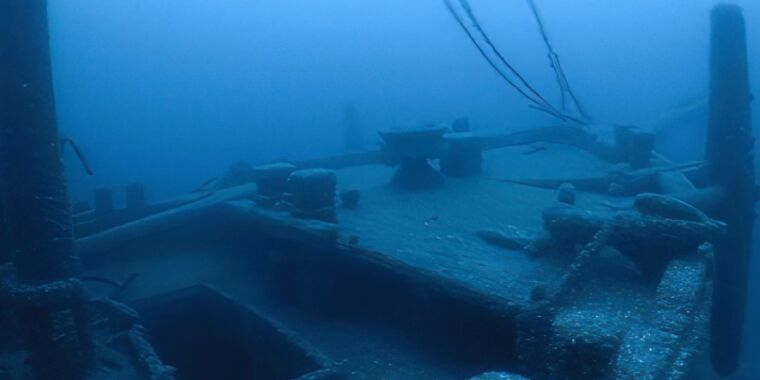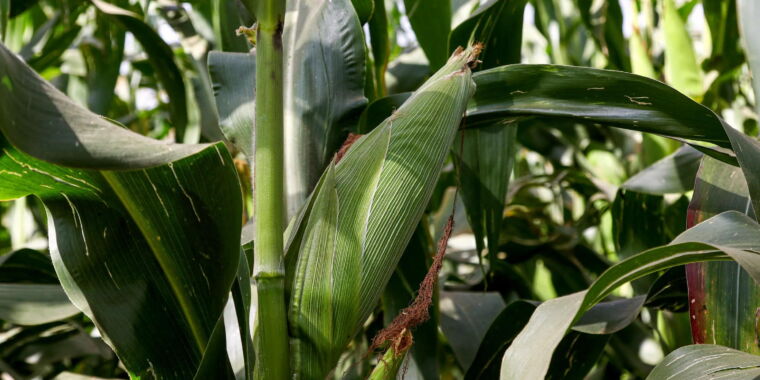Ironton, a late 19th century shipwreck, has been located in NOAA’s Thunder Bay National Marine Sanctuary.
In 1894, a schooner barge called Ironton collided with a Great Lakes freighter called Ohio in Lake Huron’s infamous “Shipwreck Alley.” Ohio‘s wreck was found in 2017 by an expedition organized by the National Oceanic and Atmospheric Administration’s (NOAA) Thunder Bay National Marine Sanctuary. Now the same team has announced its discovery of the wreck of the 191-foot Ironton nearly 130 years after its sinking, so well-preserved in the frigid waters of the Great Lakes that its three masts are still standing, and its rigging is still attached. Its discovery could help resolve unanswered questions about the ship’s final hours.
Schooner barges like Ironton were part of a fleet that helped transport wheat, coal, corn, lumber, and iron ore across the Great Lakes region, towed by steamers. At 12:30 am on September 26, 1984, Ironton and another schooner, Moonlight, were being towed unladen across Lake Huron by the steamer Charles J. Kershaw when the steamer’s engine failed. The weather was rough, and strong winds pushed the two schooners perilously close to the disabled steamer. Fearing a collision, Moonlight‘s crew cut Ironton‘s tow line, setting Ironton adrift.
Captain Peter Girard and his crew tried to regain control of the ship, but the wind blew them onto a head-on collision course with the Ohio, which was carrying 1,000 tons of grain. According to the account of surviving crew member William Wooley, it was too dark to spot the Ohio until it was too late, and Ironton struck the steamer with its starboard bow, tearing a 12-foot wide hole in Ohio‘s hull.

Ocean Exploration Trust/NOAA
Ohio sank quickly but its 16-member crew escaped in lifeboats and were rescued by nearby ships. Ironton‘s crew was less fortunate. The barge had drifted too far away, out of view from the rescue vessels. The crew boarded a lifeboat as the schooner sank but nobody remembered to untie the line securing the lifeboat, so everyone was pulled down with the ship. The one other survivor, William Parry, managed to make his way to the surface and grab onto a sailor’s bag. He noticed Wooley nearby, clinging to a box, and swam over. Eventually, they were rescued by a passing steamer, but Girard and the four other crewmates perished.
In 2017, Thunder Bay National Marine Sanctuary researchers teamed up with NOAA’s Office of Ocean Exploration and Research to search for the 100 or so lost shipwrecks they believed had sunk somewhere within the sanctuary. They used unmanned aircraft systems and autonomous underwater vehicles to take sonar scans, among other tools. That’s how they found the wreck of the Ohio, along with the Choctaw, a 267-foot steel semi-whaleback steamer that collided with the freighter Wahcondah in dense fog and sank on July 12, 1915. Almost all of the rigging and deck hardware on both ships remained intact.
-
Ironton rests hundreds of feet below the surface with its three masts standing and rigging attached to the spars, and is magnificently preserved by the cold freshwater of Lake Huron. An anchor rests still attached on the bow of the sunken schooner barge.
NOAA/ Undersea Vehicles Program UNCW -
The wooden bowsprit of Ironton reaches into the clear blue water of Lake Huron.
NOAA/Undersea Vehicles Program at University of North Carolina Wilmington -
A lifeboat rests at Ironton‘s stern.
NOAA/Undersea Vehicles Program at University of North Carolina Wilmington
Once the Ohio had been found, the team conducted further research into the weather and wind conditions on the fateful night of the double sinking to narrow down the search area for Ironton. They partnered with famed explorer Robert Ballard and the Ocean Exploration Trust to map that area in 2019. (Ballard famously discovered the wreck of the Titanic, as well as the wrecks of the battleship Bismarck and the USS Yorktown aircraft carrier, among other finds.) Finally, in the final days of the expedition, they captured a sonar image from the lakebed clearly showing a shipwreck.
There wasn’t enough detail in that sonar image to definitively identify the wreck as Ironton, so the team decided to capture video of the wreck with a remotely operated vehicle (ROV). That footage confirmed that they had found the Ironton. The site will be marked with a deep-water mooring buoy so divers can safely visit the wreck.
“The discovery illustrates how we can use the past to create a better future,” said Jeff Gray, Thunder Bay National Marine Sanctuary superintendent. “Using this cutting-edge technology, we have not only located a pristine shipwreck lost for over a century, we are also learning more about one of our nation’s most important natural resources—the Great Lakes. We will continue to map Thunder Bay National Marine Sanctuary, and this research will ultimately lead to even more discoveries about the Great Lakes and the unique collection of shipwrecks that rest on the lakebed.”
Listing image by NOAA/ Undersea Vehicles Program UNCW








